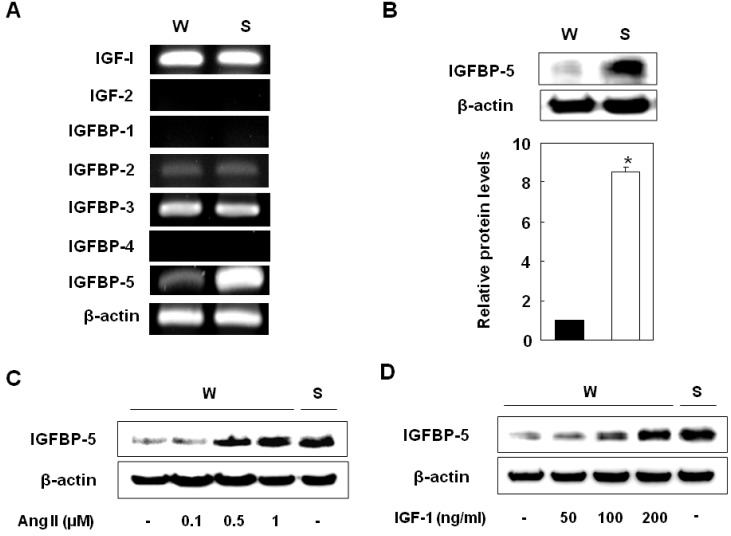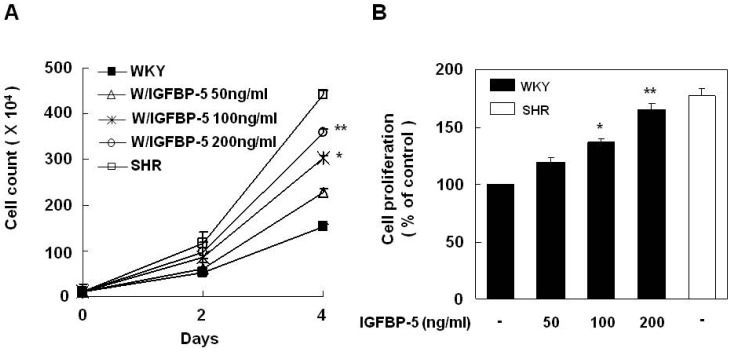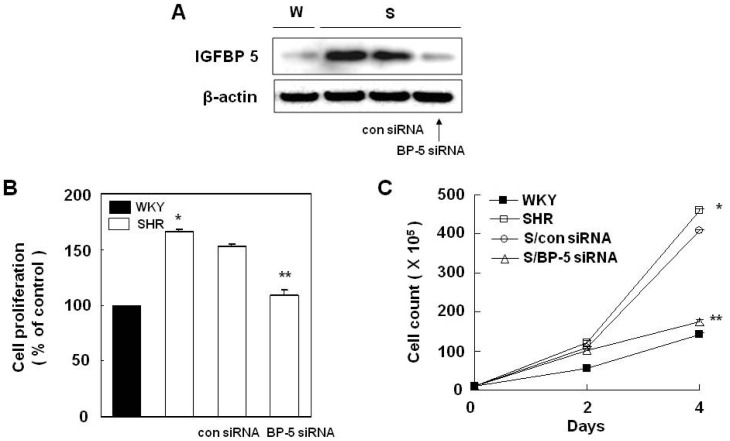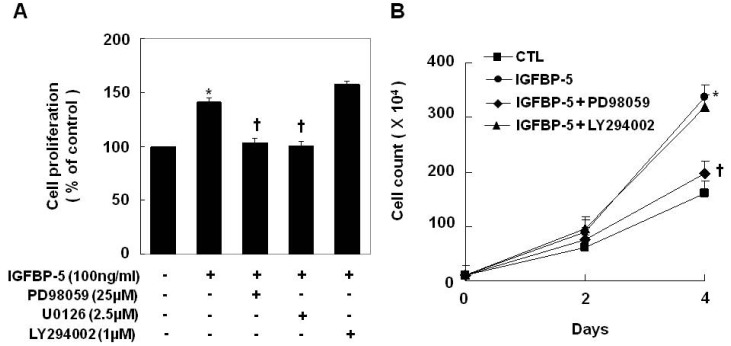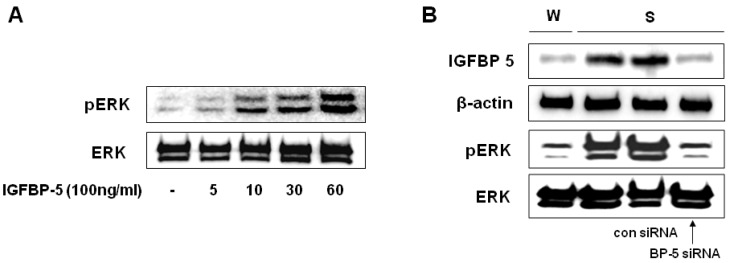Korean J Physiol Pharmacol.
2013 Apr;17(2):157-162. 10.4196/kjpp.2013.17.2.157.
Insulin Like Growth Factor Binding Protein-5 Regulates Excessive Vascular Smooth Muscle Cell Proliferation in Spontaneously Hypertensive Rats via ERK 1/2 Phosphorylation
- Affiliations
-
- 1Department of Thoracic and Cardiovascular Surgery, College of Medicine, Yeungnam University, Daegu 705-717, Korea.
- 2Department of Pharmacology, College of Medicine, Yeungnam University, Daegu 705-717, Korea. yjkang@med.yu.ac.kr
- 3Aging-Associated Vascular Disease Research Center, College of Medicine, Yeungnam University, Daegu 705-717, Korea.
- KMID: 1429387
- DOI: http://doi.org/10.4196/kjpp.2013.17.2.157
Abstract
- Insulin-like growth factor binding proteins (IGFBPs) are important components of insulin growth factor (IGF) signaling pathways. One of the binding proteins, IGFBP-5, enhances the actions of IGF-1, which include the enhanced proliferation of smooth muscle cells. In the present study, we examined the expression and the biological effects of IGFBP-5 in vascular smooth muscle cells (VSMCs) from spontaneously hypertensive rats (SHR) and Wistar Kyoto rats (WKY). The levels of IGFBP-5 mRNA and protein were found to be higher in the VSMC from SHR than in those from WKY. Treatment with recombinant IGFBP-5-stimulated VSMC proliferation in WKY to the levels observed in SHR. In the VSMCs of WKY, incubation with angiotensin (Ang) II or IGF-1 dose dependently increased IGFBP-5 protein levels. Transfection with IGFBP-5 siRNA reduced VSMC proliferation in SHR to the levels exhibited in WKY. In addition, recombinant IGFBP-5 significantly up-regulated ERK1/2 phosphorylation in the VSMCs of WKY as much as those of SHR. Concurrent treatment with the MEK1/2 inhibitors, PD98059 or U0126 completely inhibited recombinant IGFBP-5-induced VSMC proliferation in WKY, while concurrent treatment with the phosphatidylinositol-3 kinase inhibitor, LY294002, had no effect. Furthermore, knockdown with IGFBP-5 siRNA inhibited ERK1/2 phosphorylation in VSMC of SHR. These results suggest that IGFBP-5 plays a role in the regulation of VSMC proliferation via ERK1/2 MAPK signaling in hypertensive rats.
MeSH Terms
-
Angiotensins
Animals
Butadienes
Carrier Proteins
Cell Proliferation
Chromones
Flavonoids
Insulin
Insulin-Like Growth Factor Binding Protein 5
Insulin-Like Growth Factor Binding Proteins
Insulin-Like Growth Factor I
Morpholines
Muscle, Smooth, Vascular
Myocytes, Smooth Muscle
Nitriles
Phosphorylation
Phosphotransferases
Rats
Rats, Inbred SHR
Rats, Inbred WKY
RNA, Messenger
RNA, Small Interfering
Transfection
Angiotensins
Butadienes
Carrier Proteins
Chromones
Flavonoids
Insulin
Insulin-Like Growth Factor Binding Protein 5
Insulin-Like Growth Factor Binding Proteins
Insulin-Like Growth Factor I
Morpholines
Nitriles
Phosphotransferases
RNA, Messenger
RNA, Small Interfering
Figure
Cited by 2 articles
-
High Glucose Induces Connective Tissue Growth Factor Expression and Extracellular Matrix Accumulation in Rat Aorta Vascular Smooth Muscle Cells Via Extracellular Signal-Regulated Kinase 1/2
Yu Mi Ha, Dong Hyup Lee, Mina Kim, Young Jin Kang
Korean J Physiol Pharmacol. 2013;17(4):307-314. doi: 10.4196/kjpp.2013.17.4.307.Pitavastatin Regulates Ang II Induced Proliferation and Migration via IGFBP-5 in VSMC
Yu Mi Ha, Ju-Ock Nam, Young Jin Kang
Korean J Physiol Pharmacol. 2015;19(6):499-506. doi: 10.4196/kjpp.2015.19.6.499.
Reference
-
1. Delafontaine P, Song YH, Li Y. Expression, regulation, and function of IGF-1, IGF-1R, and IGF-1 binding proteins in blood vessels. Arterioscler Thromb Vasc Biol. 2004; 24:435–444. PMID: 14604834.
Article2. Clemmons DR. Modifying IGF1 activity: an approach to treat endocrine disorders, atherosclerosis and cancer. Nat Rev Drug Discov. 2007; 6:821–833. PMID: 17906644.
Article3. Duan C. Specifying the cellular responses to IGF signals: roles of IGF-binding proteins. J Endocrinol. 2002; 175:41–54. PMID: 12379489.
Article4. Hsieh T, Gordon RE, Clemmons DR, Busby WH Jr, Duan C. Regulation of vascular smooth muscle cell responses to insulin-like growth factor (IGF)-I by local IGF-binding proteins. J Biol Chem. 2003; 278:42886–42892. PMID: 12917428.
Article5. Zheng B, Clarke JB, Busby WH, Duan C, Clemmons DR. Insulin-like growth factor-binding protein-5 is cleaved by physiological concentrations of thrombin. Endocrinology. 1998; 139:1708–1714. PMID: 9528953.
Article6. Duan C, Hawes SB, Prevette T, Clemmons DR. Insulin-like growth factor-I (IGF-I) regulates IGF-binding protein-5 synthesis through transcriptional activation of the gene in aortic smooth muscle cells. J Biol Chem. 1996; 271:4280–4288. PMID: 8626775.
Article7. Kuemmerle JF, Zhou H. Insulin-like growth factor-binding protein-5 (IGFBP-5) stimulates growth and IGF-I secretion in human intestinal smooth muscle by Ras-dependent activation of p38 MAP kinase and Erk1/2 pathways. J Biol Chem. 2002; 277:20563–20571. PMID: 11923300.
Article8. Intengan HD, Schiffrin EL. Vascular remodeling in hypertension: roles of apoptosis, inflammation, and fibrosis. Hypertension. 2001; 38:581–587. PMID: 11566935.9. Resink TJ, Scott-Burden T, Baur U, Bühler FR. Increased proliferation fate and phosphoinositide turnover in cultured smooth muscle cells from spontaneously hypertensive rats. J Hypertens Suppl. 1987; 5:S145–S148. PMID: 2832572.10. Choi HC, Lee KY, Lee DH, Kang YJ. Heme oxygenase-1 induced by aprotinin inhibits vascular smooth muscle cell proliferation through cell cycle arrest in hypertensive rats. Korean J Physiol Pharmacol. 2009; 13:309–313. PMID: 19885015.
Article11. Vecchione C, Colella S, Fratta L, Gentile MT, Selvetella G, Frati G, Trimarco B, Lembo G. Impaired insulin-like growth factor I vasorelaxant effects in hypertension. Hypertension. 2001; 37:1480–1485. PMID: 11408398.
Article12. Grant MB, Wargovich TJ, Ellis EA, Tarnuzzer R, Caballero S, Estes K, Rossing M, Spoerri PE, Pepine C. Expression of IGF-I, IGF-I receptor and IGF binding proteins-1, -2, -3, -4 and -5 in human atherectomy specimens. Regul Pept. 1996; 67:137–144. PMID: 8988513.13. Colao A, Spiezia S, Di Somma C, Pivonello R, Marzullo P, Rota F, Musella T, Auriemma RS, De Martino MC, Lombardi G. Circulating insulin-like growth factor-I levels are correlated with the atherosclerotic profile in healthy subjects independently of age. J Endocrinol Invest. 2005; 28:440–448. PMID: 16075928.
Article14. Kawachi S, Takeda N, Sasaki A, Kokubo Y, Takami K, Sarui H, Hayashi M, Yamakita N, Yasuda K. Circulating insulin-like growth factor-1 and insulin-like growth factor binding protein-3 are associated with early carotid atherosclerosis. Arterioscler Thromb Vasc Biol. 2005; 25:617–621. PMID: 15625284.
Article15. Schuler-Luttmann S, Monnig G, Enbergs A, Schulte H, Breithardt G, Assmann G, Kerber S, von Eckardstein A. Insulin-like growth factor-binding protein-3 is associated with the presence and extent of coronary arteriosclerosis. Arterioscler Thromb Vasc Biol. 2000; 20:E10–E15. PMID: 10764692.
Article16. Watanabe T, Itokawa M, Nakagawa Y, Iguchi T, Katagiri T. Increased levels of insulin-like growth factor binding protein-3 in hypertensive patients with carotid atherosclerosis. Am J Hypertens. 2003; 16:754–760. PMID: 12944034.
Article17. Kim KS, Seu YB, Baek SH, Kim MJ, Kim KJ, Kim JH, Kim JR. Induction of cellular senescence by insulin-like growth factor binding protein-5 through a p53-dependent mechanism. Mol Biol Cell. 2007; 18:4543–4552. PMID: 17804819.
Article18. Bach LA. The insulin-like growth factor system in kidney disease and hypertension. Curr Opin Nephrol Hypertens. 2012; 21:86–91. PMID: 22123209.
Article19. Schneider MR, Wolf E, Hoeflich A, Lahm H. IGF-binding protein-5: flexible player in the IGF system and effector on its own. J Endocrinol. 2002; 172:423–440. PMID: 11874691.
Article20. Duan C, Liimatta MB, Bottum OL. Insulin-like growth factor (IGF)-I regulates IGF-binding protein-5 gene expression through the phosphatidylinositol 3-kinase, protein kinase B/Akt, and p70 S6 kinase signaling pathway. J Biol Chem. 1999; 274:37147–37153. PMID: 10601276.
Article21. Cobb LJ, Salih DA, Gonzalez I, Tripathi G, Carter EJ, Lovett F, Holding C, Pell JM. Partitioning of IGFBP-5 actions in myogenesis: IGF-independent anti-apoptotic function. J Cell Sci. 2004; 117:1737–1746. PMID: 15075235.
Article22. Butt AJ, Dickson KA, McDougall F, Baxter RC. Insulin-like growth factor-binding protein-5 inhibits the growth of human breast cancer cells in vitro and in vivo. J Biol Chem. 2003; 278:29676–29685. PMID: 12777377.23. Salih DA, Tripathi G, Holding C, Szestak TA, Gonzalez MI, Carter EJ, Cobb LJ, Eisemann JE, Pell JM. Insulin-like growth factor-binding protein 5 (Igfbp5) compromises survival, growth, muscle development, and fertility in mice. Proc Natl Acad Sci USA. 2004; 101:4314–4319. PMID: 15010534.
Article24. Hampel B, Fortschegger K, Ressler S, Chang MW, Unterluggauer H, Breitwieser A, Sommergruber W, Fitzky B, Lepperdinger G, Jansen-Dürr P, Voglauer R, Grillari J. Increased expression of extracellular proteins as a hallmark of human endothelial cell in vitro senescence. Exp Gerontol. 2006; 41:474–481. PMID: 16626901.
Article25. Lau KH, Baylink DJ. Molecular mechanism of action of fluoride on bone cells. J Bone Miner Res. 1998; 13:1660–1667. PMID: 9797473.
Article26. Wang J, Razuvaev A, Folkersen L, Hedin E, Roy J, Brismar K, Hedin U. The expression of IGFs and IGF binding proteins in human carotid atherosclerosis, and the possible role of IGF binding protein-1 in the regulation of smooth muscle cell proliferation. Atherosclerosis. 2012; 220:102–109. PMID: 22104117.
Article
- Full Text Links
- Actions
-
Cited
- CITED
-
- Close
- Share
- Similar articles
-
- Proliferation of Cultured Vascular Smooth Muscle Cells(VSMCs) Obtained from Aortas of Insulin Dependent Diabetic Rats
- Downregulation of Angiotensin II-Induced 12-Lipoxygenase Expression and Cell Proliferation in Vascular Smooth Muscle Cells from Spontaneously Hypertensive Rats by CCL5
- Pitavastatin Regulates Ang II Induced Proliferation and Migration via IGFBP-5 in VSMC
- The effect of Insulin like growth factor-I (IGF-I) and IGF binding protein-3 (IGFBP-3) on cellular proliferation in mouse 3T3 fibroblast cells
- Effects of Mycophenolic Acid, Rapamycin, and Carvedilol on the PDGF-induced Fibronectin Secretion by Rat Vascular Smooth Muscle Cells: Implication of MAP Kinase

